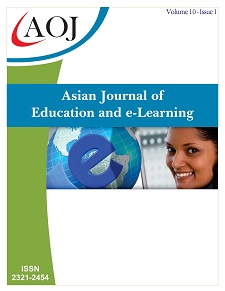Application of Task-driven Teaching Method in Business English Translation Teaching: Taking Hengyang Normal University as an Example
DOI:
https://doi.org/10.24203/ajeel.v10i1.6878Keywords:
Task-Driven Teaching Method; Business English TranslationAbstract
As a compulsory skill course for business English majors, business English translation courses should have strong social and purpose. Based on the principle of task-driven teaching method, this thesis explores the teaching strategies which can improve the translation level of business English majors by analyzing the application of task-driven teaching method in business English translation course, so that students’ level of translation can be promoted.
References
Aihua Yan. Project Driven Business English Teaching Model Based on Flipped Classroom[J]. International Journal of Education and Economics, 2020, 3 (2): 206-207.
Jia Wu. An Analysis of Key Elements of Reading Education in College English Courses under Task-Driven Environment[J]. International Journal of Intelligent Information and Management Science, 2019, 8 (5) : 346-348.
Xiaoli Gao. The Application of Situational Teaching Method in College Business English Teaching[J]. International Journal of Social Sciences in Universities, 2020,3(3): 80-82.
Yanji Liu, and Yazhe Liu. “A Study on Reform Based on Task-driven Method”. Proceedings of 2017 5th International Conference on Social Sciences Research(SSR 2017)(Advances in Social and Behavioral Sciences,VOL.21).Ed. Singapore Management and Sports Science Institute, 2017.
Yuxin Tu. “On Task-Driven Teaching Mode of College English Reading under Network Environment”. Proceedings of 2019 7th International Education, Economics, Social Science, Arts, Sports and Management Engineering Conference (IEESASM 2019). Ed. Clausius Scientific Press,Canada, 2019.
Downloads
Published
Issue
Section
License
Copyright (c) 2022 Caihong Xie, Huiyao Ye

This work is licensed under a Creative Commons Attribution-NonCommercial 4.0 International License.
- Papers must be submitted on the understanding that they have not been published elsewhere (except in the form of an abstract or as part of a published lecture, review, or thesis) and are not currently under consideration by another journal published by any other publisher.
- It is also the authors responsibility to ensure that the articles emanating from a particular source are submitted with the necessary approval.
- The authors warrant that the paper is original and that he/she is the author of the paper, except for material that is clearly identified as to its original source, with permission notices from the copyright owners where required.
- The authors ensure that all the references carefully and they are accurate in the text as well as in the list of references (and vice versa).
- Authors retain copyright and grant the journal right of first publication with the work simultaneously licensed under a Attribution-NonCommercial 4.0 International that allows others to share the work with an acknowledgement of the work's authorship and initial publication in this journal.
- Authors are able to enter into separate, additional contractual arrangements for the non-exclusive distribution of the journal's published version of the work (e.g., post it to an institutional repository or publish it in a book), with an acknowledgement of its initial publication in this journal.
- Authors are permitted and encouraged to post their work online (e.g., in institutional repositories or on their website) prior to and during the submission process, as it can lead to productive exchanges, as well as earlier and greater citation of published work (See The Effect of Open Access).
- The journal/publisher is not responsible for subsequent uses of the work. It is the author's responsibility to bring an infringement action if so desired by the author.


